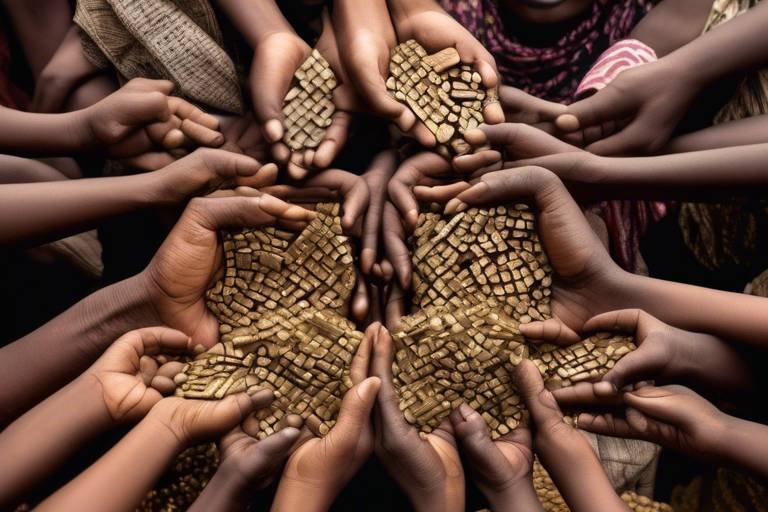How to Assess the Viability of a Blockchain Project
In the ever-evolving landscape of technology, blockchain has emerged as a revolutionary force, promising transparency, security, and decentralization. However, not all blockchain projects are created equal, and assessing their viability is crucial for investors, developers, and users alike. So, how do you determine if a blockchain project is worth your time and investment? This article explores key factors to consider when evaluating the potential success of a blockchain project, including technology, market demand, team expertise, and regulatory environment.
A thorough grasp of blockchain technology is essential for assessing a project's viability. At its core, blockchain is a decentralized ledger that records transactions across multiple computers. This ensures that the record cannot be altered retroactively without the consensus of the network, making it inherently secure and transparent. The benefits of blockchain include enhanced security, reduced fraud, and increased transparency. However, it's important to recognize its limitations, such as scalability issues and energy consumption. Understanding these fundamentals will help you gauge whether a project is leveraging the technology effectively or merely riding the hype wave.
Evaluating market demand is crucial for determining a project's potential success. If there's no significant demand for a blockchain solution, even the best technology will struggle to gain traction. Start by analyzing target markets and identifying user needs. Ask yourself: Who will benefit from this project? What problems does it solve? Additionally, consider existing competition. Are there similar projects already in the market? What unique value does this project bring to the table? Conducting a thorough market analysis will provide insights into the project's relevance and potential for growth.
Understanding the target audience helps in gauging the project's relevance. A project may have cutting-edge technology, but if it doesn't resonate with its intended users, it will likely falter. To identify and engage potential users effectively, consider the following methods:
- Conduct demographic research to understand who your potential users are.
- Analyze user behavior and preferences through social media and online forums.
- Utilize analytics tools to track engagement and feedback on similar projects.
By focusing on the needs and preferences of your target audience, you can tailor the project to ensure it meets their expectations.
Surveys and interviews can provide valuable insights into user expectations and preferences. By designing effective research methods, you can gather qualitative and quantitative data that informs your project strategy. Consider using online survey tools to reach a broader audience, and conduct one-on-one interviews for in-depth feedback. Ask open-ended questions that encourage respondents to share their thoughts and experiences. This feedback can be instrumental in shaping the project's direction and ensuring it aligns with user needs.
Keeping track of market trends is vital for understanding demand. The blockchain landscape is dynamic, and staying updated on industry developments can provide a competitive edge. Utilize tools like Google Trends, industry reports, and social media analytics to monitor shifts in user interest and emerging technologies. By analyzing these trends, you can adjust your project strategy to align with market needs and capitalize on new opportunities.
The expertise and experience of the development team play a significant role in a project's success. A skilled team can navigate challenges, innovate solutions, and adapt to changing circumstances. When evaluating a blockchain team, look for key attributes such as:
- Proven track record in blockchain development.
- Experience with relevant technologies and programming languages.
- Strong problem-solving skills and creativity.
Additionally, consider the team's ability to communicate and collaborate effectively. A cohesive team can drive a project forward, while a disjointed one may struggle to meet its goals.
Understanding the regulatory landscape is essential for blockchain projects. As governments around the world grapple with how to regulate this technology, potential legal challenges can arise. Compliance with local laws and regulations is not just a checkbox; it's a critical factor that can impact a project's viability. Failing to adhere to regulations can lead to fines, project shutdowns, or legal battles that drain resources and credibility.
Different countries have varying regulations for blockchain. It's crucial to understand these diverse regulatory environments and their implications on your project. For instance, while some countries embrace blockchain innovation, others may impose strict regulations that could hinder development. Stay informed about global regulatory changes and their potential impact on your project to navigate these challenges effectively.
Identifying and mitigating risks is crucial for project success. Blockchain ventures face unique challenges, including legal, financial, and operational risks. Develop a comprehensive risk management plan that outlines potential risks and strategies to address them. This could involve legal consultations, financial audits, and contingency plans for operational hurdles. By proactively managing risks, you can enhance the project's resilience and increase its chances of success.
Q1: What is blockchain technology?
A: Blockchain technology is a decentralized digital ledger that records transactions across multiple computers, ensuring security and transparency.
Q2: How do I assess market demand for a blockchain project?
A: Analyze target markets, identify user needs, and evaluate existing competition to gauge market demand effectively.
Q3: Why is the development team important for a blockchain project?
A: A skilled development team is crucial for navigating challenges, innovating solutions, and ensuring the project aligns with user needs.
Q4: What regulatory considerations should I be aware of?
A: Understanding local and global regulations is essential to ensure compliance and avoid potential legal challenges that could impact your project.

Understanding Blockchain Technology
To truly assess the viability of any blockchain project, you need to dive deep into the very essence of what blockchain technology is. At its core, blockchain is a decentralized digital ledger that records transactions across many computers in such a way that the registered transactions cannot be altered retroactively. This means that once a piece of data is recorded, it becomes nearly impossible to change it without the consensus of the network. Imagine a public library where each book represents a block of data, and every time a new book is added, it gets chained to the previous one, creating a complete history of information. This structure is what provides blockchain with its inherent security and transparency.
One of the most significant benefits of blockchain technology is its transparency. All transactions are visible to participants in the network, which builds trust and accountability. This transparency is particularly valuable in industries such as finance, supply chain, and healthcare, where tracking the provenance of goods and services is crucial. However, while blockchain offers many advantages, it also comes with limitations. For instance, scalability can be a challenge; as more transactions are added, the network can become congested, leading to slower processing times and higher fees.
In addition to understanding the basic structure and benefits, it's essential to recognize the different types of blockchain. There are primarily three types: public, private, and consortium blockchains. Public blockchains, like Bitcoin and Ethereum, are open to anyone and are fully decentralized. Private blockchains, on the other hand, are restricted to a specific group of users, often used by businesses for internal purposes. Consortium blockchains fall somewhere in between, where multiple organizations share control over the network. Each type has its own use cases, advantages, and disadvantages, making it crucial to choose the right one based on the project's goals.
Moreover, the smart contract feature of blockchain technology deserves attention. Smart contracts are self-executing contracts with the terms of the agreement directly written into code. They automatically enforce and execute the terms of a contract when predetermined conditions are met, reducing the need for intermediaries. This not only enhances efficiency but also minimizes the potential for disputes, making blockchain projects more appealing to businesses looking to streamline operations.
In summary, understanding blockchain technology is not just about knowing how it works; it’s about grasping its implications for various industries and its potential to reshape the way we conduct transactions. As you evaluate a blockchain project, keep in mind the technology's strengths and weaknesses, its types, and the innovative features it offers, such as smart contracts. This comprehensive understanding will equip you to make informed judgments about a project's viability in the ever-evolving landscape of blockchain technology.

Market Demand Analysis
When diving into the world of blockchain projects, one of the most critical elements to assess is market demand. Understanding whether there is a genuine need for the solution your project offers can be the difference between success and failure. After all, what good is a revolutionary technology if no one wants to use it? To effectively evaluate market demand, you need to consider various factors, including target markets, user needs, and the competitive landscape. This multifaceted approach will help you paint a clearer picture of your project's potential viability.
First and foremost, analyzing the target audience is essential. Who are the people or businesses that will benefit from your blockchain solution? Identifying your audience not only helps in tailoring your product to meet their needs but also aids in crafting effective marketing strategies. Think of it like casting a fishing line; you want to ensure you’re fishing in the right pond. Engaging with potential users through various methods can provide invaluable insights into their expectations and preferences.
To effectively gauge your project's relevance, you can utilize several methods to identify and engage potential users. Start by conducting market research. This can include analyzing demographic data, behavioral patterns, and even psychographics. You might want to explore the following:
- Demographic information: Age, gender, income level, education, etc.
- Behavioral patterns: How do potential users currently solve the problem your project addresses?
- Psychographics: What are the interests, values, and lifestyles of your target audience?
By understanding these factors, you can tailor your blockchain solution to meet the specific needs of your audience, ensuring that your project is not only relevant but also appealing.
Another effective method to gain insights into user expectations is through surveys and interviews. Designing a well-structured survey can help you gather quantitative data about user preferences, while interviews can provide qualitative insights. When crafting your survey, consider including questions that cover:
- Current challenges users face in their existing solutions
- Desired features and functionalities in a new blockchain solution
- Willingness to adopt new technologies
Implementing these research methods can help you create a product that resonates with your audience and meets their needs effectively.
Keeping an eye on market trends is vital in understanding the demand for your project. The blockchain landscape is ever-evolving, and new trends can emerge overnight. Utilizing tools like Google Trends, industry reports, and social media analytics can provide you with a wealth of information about what’s currently capturing attention in the market. This information not only helps you identify gaps in the market but also allows you to pivot your project to align with emerging trends, ensuring that you stay ahead of the competition.
In conclusion, conducting a thorough market demand analysis is a crucial step in assessing the viability of your blockchain project. By identifying your target audience, engaging with them through surveys and interviews, and keeping track of market trends, you can position your project for success. Remember, the blockchain revolution is not just about technology; it’s about solving real-world problems for real people.
Q: How can I effectively conduct market research for my blockchain project?
A: You can use a combination of surveys, interviews, and data analysis tools to gather insights about your target audience and market trends.
Q: Why is understanding my target audience so important?
A: Knowing your target audience helps you tailor your product to meet their specific needs and increases the likelihood of adoption.
Q: What tools can I use to analyze market trends?
A: Tools like Google Trends, social media analytics platforms, and industry reports are excellent resources for tracking market trends.

Identifying Target Audience
Identifying the target audience for a blockchain project is like finding the right key for a lock; without it, you may struggle to unlock the potential success of your venture. Understanding who your users are, what they need, and how they interact with technology is crucial for tailoring your project to meet their expectations. So, how do you go about pinpointing your audience? It involves a combination of research, analysis, and a bit of intuition.
First off, you want to dive deep into demographics. Think about age, gender, location, and even income levels. For instance, if your blockchain project is aimed at financial services, you might want to target tech-savvy millennials who are already familiar with digital currencies. Conversely, if your project focuses on supply chain management, your audience could include businesses of various sizes looking for efficiency and transparency. By segmenting your audience based on these factors, you can create more tailored marketing strategies that resonate with them.
Next, it’s essential to understand the psychographics of your target audience. This includes their interests, values, and lifestyle choices. Are they early adopters who love experimenting with new technologies, or are they more conservative and hesitant about change? To gather this information, consider utilizing tools like social media analytics, which can provide insights into user behavior and preferences. Engaging with online communities, forums, or even social media groups related to blockchain can also offer a wealth of information about what potential users are talking about and what they expect from a product like yours.
Another effective method for identifying your target audience is to conduct user persona development. Creating detailed personas can help you visualize your ideal users. A persona might include information like:
- Name: Tech-Savvy Tom
- Age: 28
- Occupation: Software Engineer
- Interests: Cryptocurrency trading, blockchain technology, and fintech innovations
- Goals: To invest in reliable blockchain projects that promise returns
By developing such personas, you can tailor your marketing messages and product features to better align with the needs and desires of your audience.
Lastly, don’t underestimate the power of feedback. Once you have a prototype or a minimum viable product (MVP), get it in front of potential users as quickly as possible. Their feedback will be invaluable in refining your project. You can conduct user testing sessions, where participants interact with your product and provide real-time insights. This approach not only helps you understand your audience better but also builds a community around your project, fostering loyalty even before your official launch.
In conclusion, identifying your target audience is an ongoing process that requires continuous engagement and adaptation. By leveraging demographic and psychographic data, creating user personas, and actively seeking feedback, you can ensure that your blockchain project is not only viable but also positioned for success in a competitive market.

Conducting Surveys and Interviews
When it comes to assessing the viability of a blockchain project, conducting surveys and interviews is like striking gold in a mine. These methods provide invaluable insights into user expectations and preferences, helping you understand what potential users truly want. Imagine you're a chef trying to create the perfect dish; wouldn't you want to know the tastes and preferences of your diners? Similarly, surveys and interviews can guide you in tailoring your project to meet the needs of your target audience.
To get started, it's essential to design your surveys and interviews thoughtfully. A well-structured survey can be a treasure map, leading you to the insights you seek. Begin by crafting clear and concise questions that cover various aspects of your project—ranging from user experience to specific features they find appealing. You might consider using a mix of open-ended and closed-ended questions. For instance:
- Closed-ended questions: These can include multiple-choice or rating scale questions, such as "How likely are you to use a blockchain wallet on a scale of 1 to 5?"
- Open-ended questions: These allow respondents to express their thoughts freely, like "What features do you wish to see in a blockchain application?"
Next, think about the medium you'll use to distribute your surveys. Online platforms such as Google Forms or SurveyMonkey are fantastic for reaching a broad audience quickly and efficiently. Moreover, social media channels can be a goldmine for gathering responses, especially if you're targeting a tech-savvy demographic. Don't forget to incentivize participation; offering a small reward, like a discount or entry into a raffle, can significantly boost your response rate.
Interviews, on the other hand, provide a deeper dive into user sentiments. They allow for a more personal connection, where you can probe deeper into users' thoughts and feelings about your project. When conducting interviews, consider these tips:
- Choose the right participants: Aim for a diverse group that represents your target audience, ensuring you get a well-rounded perspective.
- Create a comfortable environment: Whether in-person or virtual, make sure your interviewees feel at ease. This will encourage them to share their honest opinions.
- Listen actively: Pay close attention to what your interviewees are saying. Sometimes, the most valuable insights come from follow-up questions based on their responses.
After gathering the data, it's time to analyze the results. Look for patterns and common themes that emerge from your surveys and interviews. Are there specific features that users consistently mention? Are there pain points that need to be addressed? This analysis will serve as a guiding star, illuminating the path forward for your blockchain project.
In conclusion, conducting surveys and interviews is not just a box to tick off; it's a crucial step in understanding your audience and ensuring your blockchain project resonates with them. By investing time and effort into this research, you're laying a solid foundation for your project's success. So grab your survey tools and start connecting with potential users—your project's future could depend on it!
- Why are surveys important for blockchain projects? Surveys help you gather direct feedback from potential users, allowing you to tailor your project to meet their needs.
- How can I increase survey participation? Consider offering incentives, promoting your survey on social media, and keeping your questions concise and engaging.
- What are the benefits of conducting interviews? Interviews allow for deeper insights and a personal connection with users, helping you understand their thoughts and feelings more thoroughly.
- What should I do with the data collected? Analyze the data to identify trends and insights that can inform your project's development and marketing strategy.

Analyzing Market Trends
In the fast-paced world of blockchain, staying ahead of market trends is not just an advantage; it’s a necessity. As the landscape evolves, the ability to anticipate changes can be the difference between a project that thrives and one that fizzles out. So, how do you effectively analyze these trends? First, it’s essential to understand that market trends can be influenced by various factors, including technological advancements, user behavior, and regulatory shifts. By keeping a close eye on these elements, you can better position your blockchain project for success.
One effective method for analyzing market trends is through the use of data analytics tools. These tools can provide insights into user engagement, transaction volumes, and even social media sentiment. For instance, platforms like Google Trends can help you gauge the popularity of specific blockchain-related keywords over time, while tools like Token Metrics or CoinMarketCap can provide valuable data on market capitalization and trading volumes of various cryptocurrencies. This data can help you identify emerging trends and potential shifts in user interest.
Additionally, it's crucial to engage with the community. The blockchain community is vibrant and vocal, often sharing insights and opinions that can be invaluable for trend analysis. Participating in forums, attending conferences, and following thought leaders on social media can provide a wealth of information. You might even consider conducting your own research through surveys or polls to gather direct feedback from potential users. This grassroots approach can help you understand what features or improvements your audience is craving, which can significantly influence your project’s direction.
Moreover, keeping an eye on your competitors is equally important. Analyzing what successful projects are doing can provide insights into market demands and gaps that your project could fill. Consider creating a
| Project Name | Market Cap | Unique Features | User Engagement |
|---|---|---|---|
| Project A | $500M | Smart Contracts, NFT Marketplace | High |
| Project B | $300M | Decentralized Finance | Medium |
| Project C | $700M | Cross-Chain Compatibility | Very High |
This table not only helps you visualize where you stand in the market but also highlights potential areas for innovation. By identifying what competitors offer and where they fall short, you can carve out a unique niche for your project.
Finally, remember that market trends are not static; they evolve. Regularly revisiting your analysis and adapting your strategies accordingly is crucial. Consider setting up a periodic review process—maybe quarterly or bi-annually—to reassess the market landscape and adjust your project’s goals. In the world of blockchain, being flexible and responsive to trends can ultimately lead to a project’s success.
- What tools can I use to analyze blockchain market trends? Data analytics tools like Google Trends, Token Metrics, and CoinMarketCap are excellent starting points.
- How important is community engagement in analyzing trends? Extremely important! Engaging with the community can provide direct insights into user needs and expectations.
- Should I monitor competitors? Yes, monitoring competitors helps you understand market demands and identify gaps your project can fill.

Evaluating the Development Team
When it comes to the success of a blockchain project, the development team is like the backbone of the entire operation. Think of them as the architects and builders of a skyscraper; without a solid team, the structure is bound to crumble. So, what should you look for when evaluating a blockchain development team? Well, let’s dive into the key attributes that can make or break your project.
First and foremost, you want to assess the technical expertise of the team. This includes their experience with blockchain technology, programming languages, and development frameworks. A team well-versed in languages like Solidity, JavaScript, or Go is essential for building robust smart contracts and decentralized applications. It's like choosing a chef who knows how to make the perfect soufflé – you want someone who understands the nuances of the craft.
Another critical factor to consider is the team’s past projects. Have they successfully launched blockchain applications before? Reviewing their portfolio can provide insights into their capabilities and the quality of their work. This is akin to checking a restaurant's menu before dining in; you want to see if their previous dishes were well-received by customers. Look for case studies or testimonials that highlight their achievements and the challenges they overcame.
Moreover, the diversity of skills within the team is equally important. A well-rounded team should consist of developers, designers, project managers, and even marketing experts. This combination ensures that all aspects of the project are covered, from coding to user experience and market strategy. If all you have are developers, it’s like trying to build a car without considering the design or marketing it once it’s built. A diverse team can tackle problems from multiple angles, ensuring a smoother development process.
Communication skills also play a pivotal role in a team's effectiveness. A team that communicates well can adapt quickly to changes and challenges, making it more agile and responsive. Ask yourself: do they provide regular updates? Are they open to feedback? Just like in any relationship, effective communication can lead to a more harmonious and productive collaboration.
Lastly, consider the team's commitment to ongoing education and industry involvement. The blockchain space is continually evolving, and a team that stays updated with the latest trends and technologies is more likely to succeed. Look for signs of their participation in conferences, workshops, or contributions to open-source projects. It’s like being a gardener who continually learns about new techniques to grow the best plants; the more knowledge they have, the better the results.
In summary, evaluating the development team is a multifaceted process that requires a keen eye for detail. By focusing on their technical expertise, past projects, diversity of skills, communication abilities, and commitment to learning, you can better gauge their potential to bring your blockchain project to life. After all, a great idea deserves an equally great team to turn it into reality.
- What is the most important factor when evaluating a blockchain team? While all attributes are important, technical expertise is often considered the most critical factor.
- How can I assess a team's past projects? Review their portfolio, look for case studies, and read testimonials from previous clients.
- Why is team diversity important? A diverse team can approach problems from various perspectives, enhancing creativity and problem-solving.
- How do communication skills affect project success? Effective communication fosters collaboration and adaptability, which are essential in a dynamic environment like blockchain development.
- What should I look for in their commitment to ongoing education? Check for their participation in industry events, workshops, and contributions to relevant projects.

Regulatory and Compliance Considerations
When diving into the world of blockchain projects, one cannot overlook the regulatory and compliance landscape. Understanding this intricate web of laws is not just important; it’s absolutely essential for the survival of any blockchain initiative. Think of it as the foundation of a house; without a solid base, even the most beautiful structure can crumble. Regulatory frameworks vary significantly across different jurisdictions, and navigating these waters can be quite the challenge. So, how do you ensure that your blockchain project is on the right side of the law?
First off, it's crucial to familiarize yourself with the global regulatory frameworks that govern blockchain technology. Countries like the United States, the European Union, and China each have their own sets of rules and guidelines. For instance, while the U.S. has a relatively open approach to blockchain, it also has stringent regulations regarding securities and financial transactions. On the other hand, China has adopted a more cautious stance, imposing strict bans on certain blockchain activities. This disparity means that a project that thrives in one country could face dire challenges in another. Therefore, conducting a thorough analysis of the regulatory environment in your target market is imperative.
Moreover, it’s not just about understanding existing regulations; it’s also about anticipating future changes. The blockchain space is evolving rapidly, and with it, regulatory frameworks are also shifting. Keeping an eye on legislative developments and engaging with legal experts can help you stay ahead of the curve. This proactive approach can save your project from potential legal pitfalls down the road.
Another critical aspect is risk management strategies. Identifying potential risks and developing strategies to mitigate them is crucial for any blockchain venture. This includes not only legal risks but also financial and operational risks. For example, consider the possibility of regulatory changes that could impact your project. Having a robust risk management plan in place can help you adapt swiftly to these changes.
In addition to legal risks, operational risks such as cybersecurity threats can also pose significant challenges. Blockchain projects are often targets for hackers due to the high value of cryptocurrencies and the sensitive nature of data stored on the blockchain. Implementing strong security protocols and regularly updating them can help safeguard your project from such threats.
In summary, the regulatory and compliance considerations for blockchain projects are multifaceted and require diligent attention. By understanding the regulatory frameworks, anticipating changes, and implementing effective risk management strategies, you can significantly enhance the viability of your blockchain project. Remember, staying informed and adaptable in this ever-changing environment is key to navigating the complexities of blockchain regulations.
- What are the main regulatory challenges for blockchain projects? Regulatory challenges can include compliance with securities laws, anti-money laundering (AML) regulations, and data protection laws.
- How can I stay updated on regulatory changes? Follow industry news, subscribe to regulatory updates from legal firms, and participate in blockchain forums and discussions.
- Is it necessary to hire a legal expert for my blockchain project? While not mandatory, having legal expertise can help navigate complex regulations and avoid potential legal issues.

Global Regulatory Frameworks
When it comes to assessing the viability of a blockchain project, understanding the is absolutely crucial. Each country has its own set of rules and regulations that govern the use of blockchain technology, cryptocurrencies, and initial coin offerings (ICOs). These regulations can significantly impact how a project operates, its legal standing, and ultimately, its success in the market. So, why should we care about these frameworks? Well, without a solid understanding of the legal landscape, a project may face unexpected challenges that could derail its progress.
For instance, some countries have embraced blockchain technology and cryptocurrencies, creating a favorable environment for innovation. On the other hand, there are nations that have imposed strict regulations or outright bans, leaving projects in a state of uncertainty. This dynamic can be likened to navigating a maze—one wrong turn could lead to a dead end. Therefore, it's essential to analyze the regulatory climate of the regions where the project intends to operate.
To make things clearer, let's break down some of the key regulatory aspects that blockchain projects should consider:
- Licensing Requirements: Many jurisdictions require blockchain projects to obtain specific licenses to operate legally. This can include licenses for cryptocurrency exchanges, payment processors, and more.
- Tax Implications: Understanding how different countries tax cryptocurrency transactions and holdings is vital. Some nations have favorable tax treatments, while others may impose heavy taxes that could affect a project's profitability.
- Consumer Protection Laws: Regulations designed to protect consumers can influence how blockchain projects interact with their users. Ensuring compliance with these laws is essential for maintaining trust and credibility.
Moreover, the regulatory environment is constantly evolving. Governments around the world are actively working to create frameworks that can accommodate the rapid development of blockchain technology. This means that a project must not only comply with existing regulations but also stay informed about potential changes that could impact its operations. The ability to adapt to these changes is a key factor in a project's long-term viability.
For example, in the European Union, the Markets in Crypto-Assets (MiCA) regulation aims to create a comprehensive regulatory framework for cryptocurrencies. This initiative is designed to provide legal clarity and foster innovation while ensuring consumer protection. Understanding such regulations can provide a competitive edge and help projects align with best practices.
In conclusion, when evaluating a blockchain project, it's imperative to consider the global regulatory frameworks that govern its operation. By doing so, you not only mitigate risks but also position the project for success in a complex and ever-changing landscape. Remember, staying informed and adaptable is key to navigating the intricacies of the blockchain world.
- What are the key factors to consider when assessing a blockchain project? Key factors include technology, market demand, team expertise, and regulatory environment.
- Why is understanding regulatory frameworks important? Regulatory frameworks can affect a project's legality, operations, and overall success in the market.
- How can a project stay compliant with regulations? By keeping abreast of legal changes and ensuring that all operational practices align with local and international laws.

Risk Management Strategies
When diving into the world of blockchain, risk management isn't just a box to check; it's a critical component that can make or break a project. Think of it like navigating a ship through stormy seas—without a solid plan, you risk capsizing. The first step in effective risk management is identifying potential risks, which can range from legal challenges and financial uncertainties to operational hurdles. Each of these risks requires a tailored approach to mitigate their impact on the project's success.
One effective strategy is to conduct a thorough risk assessment at the project's inception. This involves analyzing both internal and external factors that could pose threats. For instance, internal risks may include the technology stack's reliability or the team's skill set, while external risks could encompass regulatory changes or market volatility. By categorizing these risks, teams can prioritize which ones require immediate attention and develop action plans accordingly.
To illustrate, consider a hypothetical blockchain project aiming to revolutionize supply chain management. The team might identify the following risks:
| Risk Type | Description | Mitigation Strategy |
|---|---|---|
| Regulatory Risk | Potential changes in laws affecting blockchain usage. | Engage legal experts to stay updated on regulations. |
| Technological Risk | Reliability of the chosen blockchain platform. | Conduct rigorous testing and have backup systems in place. |
| Market Risk | Competition from existing solutions. | Differentiate through unique value propositions. |
Furthermore, it's essential to develop a contingency plan. This plan acts as a safety net, allowing teams to pivot quickly if a risk materializes. For example, if regulatory hurdles arise, having a legal team on standby can ensure that the project remains compliant and can adapt to the new landscape without significant delays. Similarly, if market demand shifts unexpectedly, teams should be ready to adjust their strategies to meet new consumer needs.
Another vital aspect of risk management is fostering a culture of transparency and communication within the team. By encouraging open discussions about risks and challenges, team members can collaborate to find solutions more effectively. Regular meetings can help in assessing the current risk landscape and ensure that everyone is on the same page. This proactive approach not only helps in managing risks but also builds trust among team members.
In conclusion, successful risk management in blockchain projects is about being proactive rather than reactive. By identifying risks early, developing mitigation strategies, and maintaining open lines of communication, teams can navigate the complexities of the blockchain landscape more effectively. Remember, in the world of blockchain, the only constant is change, and being prepared for the unexpected is key to staying afloat.
- What are the main risks associated with blockchain projects?
Risks can include regulatory challenges, technological failures, market competition, and financial uncertainties. - How can I identify potential risks in my blockchain project?
Conduct a thorough risk assessment, analyze both internal and external factors, and prioritize risks based on their potential impact. - What is a contingency plan?
A contingency plan is a strategy developed to address potential risks that could hinder a project's success, allowing teams to pivot quickly when necessary. - Why is communication important in risk management?
Open communication fosters collaboration and trust among team members, leading to more effective identification and mitigation of risks.
Frequently Asked Questions
- What are the key factors to consider when assessing a blockchain project?
When evaluating a blockchain project, it's essential to look at several critical factors. These include the underlying technology, market demand, the expertise of the development team, and the regulatory environment. Each of these elements plays a significant role in determining the project's overall viability and potential for success.
- How can I understand blockchain technology better?
Grasping blockchain technology involves understanding its structure, benefits, and limitations. There are numerous resources available, including online courses, articles, and community forums. Engaging with these materials can provide a solid foundation and help you appreciate how blockchain functions and its potential applications.
- Why is market demand analysis important?
Market demand analysis is crucial because it helps you gauge whether there is a real need for the project you are assessing. By evaluating target markets, user needs, and existing competition, you can determine if the project has the potential to succeed in a crowded marketplace.
- How do I identify the target audience for a blockchain project?
Identifying the target audience involves conducting thorough research to understand who will benefit from the project. This can include demographic studies, user personas, and market segmentation. Engaging with potential users through surveys and interviews can also provide valuable insights into their expectations and preferences.
- What methods can I use to conduct effective surveys and interviews?
To conduct effective surveys and interviews, start by defining clear objectives and questions that you want to answer. Use online survey tools and consider both qualitative and quantitative methods. Make sure to analyze the data collected to draw meaningful conclusions that can guide your assessment of the project.
- How can I keep track of market trends in the blockchain industry?
Monitoring market trends can be done through various tools and strategies, such as subscribing to industry reports, following key influencers on social media, and participating in blockchain forums. Regularly checking news outlets and research publications can also keep you informed about the latest developments and shifts in the market.
- What should I look for in a blockchain development team?
When evaluating a blockchain development team, consider their experience, technical skills, and past project successes. Look for a diverse team with a mix of expertise in blockchain technology, software development, and project management. A strong team is often a good indicator of a project's potential success.
- Why is understanding the regulatory landscape important for blockchain projects?
Understanding the regulatory landscape is vital because different countries have varying regulations that can impact the project's viability. Compliance with local laws is essential to avoid legal challenges and ensure the project's long-term success. Being aware of these regulations can help you navigate potential hurdles effectively.
- What are some common risk management strategies for blockchain projects?
Common risk management strategies include conducting thorough due diligence, implementing robust security measures, and creating contingency plans for potential legal, financial, and operational risks. Regularly reviewing and updating these strategies can help mitigate risks and enhance the project's chances of success.



















